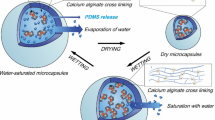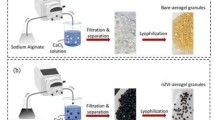Abstract
Sodium polyacrylate (PAA-Na) was selected as a polymer to modify sodium bentonite (NaB) to improve its chemical compatibility, thereby improving the hydraulic properties of polymer-modified bentonite–sand mixtures (PMBS). In this study, scanning electron microscopy (SEM) and energy dispersive spectroscopy (EDS) were used to clarify the modification mechanism of polymer-modified bentonite (PMB). The free swell index and hydraulic conductivity tests were conducted to determine the effects of ions, pH, non-prehydration, and wet–dry cycles on the hydraulic properties of PMBS and sodium bentonite–sand mixtures (NaBS). SEM–EDS results confirmed that a cluster of bentonite particles, including micropores, were wrapped by a three-dimensional crosslinked network structure of PAA-Na. Compared with the free swell index (FSI) of NaB (35 mL/2 g), the FSI of PMB increased to 86 mL/2 g in deionized water, and the FSI of PMB was found to be 2–3 times higher than that of NaB in all tested solutions. The results of hydraulic conductivity tests showed that with identical compaction levels, PMBS, with hydraulic conductivities of less than 1 × 10−8 cm/s in all permeant liquids, had lower hydraulic conductivities than that of NaBS. In addition, PMBS exhibited excellent self-healing capacity, with almost all the surface cracks being able to heal after nine wet–dry cycles involving tap water, so that PMBS could always maintain a very low hydraulic conductivity of around 5 × 10−9 cm/s. In contrast, the volume of NaBS shrank by 8.15% after nine wet–dry cycles, leading to an increase of four orders of magnitude in its hydraulic conductivity.










Similar content being viewed by others
Data Availability
The data used to support the findings of this study are available from the corresponding author upon reasonable request.
References
ASTM D4318 (2010) Standard test methods for liquid limit, plastic limit and plasticity index of soils. ASTM International, West Conshohocken, PA, USA
ASTM D5856 (2015) Standard test method for measurement of hydraulic conductivity of porous material using a rigid-wall, compaction-mold permeameter. ASTM International, West Conshohocken, PA, USA
ASTM D5890 (2011) Standard test method for swell index of clay mineral component of geosynthetic clay liners. ASTM International, West Conshohocken, PA, USA
ASTM D5993 (2014) Standard test method for measuring mass per unit of geosynthetic clay liners. ASTM International, West Conshohocken, PA, USA
ASTM D6913 (2017) Standard test methods for particle-size distribution (graduation) of soils using sieve analysis. ASTM International, West Conshohocken, PA, USA
ASTM D698 (2012) Standard test methods for laboratory compaction characteristics of soil using standard effort. ASTM International, West Conshohocken, PA, USA
ASTM D7503 (2018) Standard test method for measuring the exchange complex and cation exchange capacity of inorganic fine-grained soils. ASTM International, West Conshohocken, PA, USA
ASTM D854 (2014) Standard test methods for specific gravity of soil solids by water pycnometer. ASTM International, West Conshohocken, PA, USA
Bouazza A, Vangpaisal T, Jefferis S (2006) Effect of wet–dry cycles and cation exchange on gas permeability of geosynthetic clay liners. J Geotech Geoenviron Eng 132:1011–1018. https://doi.org/10.1061/(asce)1090-0241(2006)132:8(1011)
Chai J-C, Prongmanee N (2020) Barrier properties of a geosynthetic clay liner using polymerized sodium bentonite. Geotext Geomembranes 48:392–399. https://doi.org/10.1016/j.geotexmem.2019.12.010
Chen JN, Benson CH, Edil TB (2018) Hydraulic conductivity of geosynthetic clay liners with sodium bentonite to coal combustion product leachates. J Geotech Geoenviron Eng 144. https://doi.org/10.1061/(ASCE)GT.1943-5606.0001844
Chen JN, Tian K, Benson CH (2019) Hydraulic conductivity of bentonite-polymer geosynthetic clay liners to coal combustion product leachates. Environ Sci Eng. Springer Singapore. https://doi.org/10.1007/978-981-13-2224-2_82
Chu Y, Zhu S, Xia M, Wang F, Lei W (2020) Methionine-montmorillonite composite – a novel material for efficient adsorption of lead ions. Adv Powder Technol 31:708–717. https://doi.org/10.1016/j.apt.2019.11.026
Codevilla M, Casagrande C, Montoro M, Orlandi S, Piqué T, Manzanal D (2021) Evaluation of sand-clay-anionic polyacrylamide blends for alternative compacted clay landfill liner design. MATEC Web Conf 337:04002. https://doi.org/10.1051/matecconf/202133704002
De Camillis M, Di Emidio G, Bezuijen A, Verastegui Flores D, Van Stappen J, Cnudde V (2017) Effect of Wet–dry cycles on polymer treated bentonite in seawater: swelling ability, hydraulic conductivity and crack analysis. Appl Clay Sci 142:52–59. https://doi.org/10.1016/j.clay.2016.11.011
Demdoum A, Gueddouda MK, Goual I (2017) Effect of water and leachate on hydraulic behavior of compacted bentonite, calcareous sand and tuff mixtures for use as landfill liners. Geotech Geol Eng 35:2677–2696. https://doi.org/10.1007/s10706-017-0270-4
Dimitrova RS, Yanful EK (2012) Factors affecting the shear strength of mine tailings/clay mixtures with varying clay content and clay mineralogy. Eng Geol 125:11–25. https://doi.org/10.1016/j.enggeo.2011.10.013
Dutta J, Mishra AK (2015) A study on the influence of inorganic salts on the behaviour of compacted bentonites. Appl Clay Sci 116–117:85–92. https://doi.org/10.1016/j.clay.2015.08.018
El-Dib FI, Tawfik FM, Eshaq G, Hefni HHH, ElMetwally AE (2016) Remediation of distilleries wastewater using chitosan immobilized bentonite and bentonite based organoclays. Int J Biol Macromol 86:750–755. https://doi.org/10.1016/j.ijbiomac.2016.01.108
Garvin SL, Hayles CS (1999) The chemical compatibility of cement–bentonite cut-off wall material. Constr Build Mater 13:329–341. https://doi.org/10.1016/S0950-0618(99)00024-0
Hosney MS, Rowe RK (2017) Performance of polymer-enhanced bentonite–sand mixture for covering arsenic-rich gold mine tailings for up to 4 years. Can Geotech J 54:588–599. https://doi.org/10.1139/cgj-2016-0375
Jaynes DB (1990) Temperature variations effect on field-measured infiltration. Soil Sci Soc Am J 54:305–312. https://doi.org/10.2136/sssaj1990.03615995005400020002x
Jo HY, Katsumi T, Benson CH, Edil TB (2001) Hydraulic conductivity and swelling of nonprehydrated GCLs permeated with single-species salt solutions. J Geotech Geoenviron Eng 127:557–567. https://doi.org/10.1061/(asce)1090-0241(2001)127:7(557)
Katsumi T, Ishimori H, Ogawa A, Maruyamam S, Fukagawaiv R (2008a) Effects of water content distribution on hydraulic conductivity of prehydrated GCLS against calcium chloride solutions. Soils Found 48:407–417. https://doi.org/10.3208/sandf.48.407
Katsumi T, Ishimori H, Onikata M, Fukagawa R (2008b) Long-term barrier performance of modified bentonite materials against sodium and calcium permeant solutions. Geotext Geomembranes 26:14–30. https://doi.org/10.1016/j.geotexmem.2007.04.003
Keerthana S, Arnepalli DN (2022) Hydraulic performance of polymer-modified bentonites for development of modern geosynthetic clay liners: a review. Int J Geosynth Gr Eng 8:24. https://doi.org/10.1007/s40891-022-00368-0
Keerthana S, Asce SM, Arnepalli DN, Asce M (2022) Effect of inorganic solutions on the free swell index of polymerized clays. 11–20. https://doi.org/10.1061/9780784484050.002
Kohno M, Nara Y, Kato M, Nishimura T (2018) Effects of clay-mineral type and content on the hydraulic conductivity of bentonite–sand mixtures made of Kunigel bentonite from Japan. Clay Miner 53:721–732. https://doi.org/10.1180/clm.2018.52
Kolstad DC, Benson CH, Edil TB, Jo HY (2004) Hydraulic conductivity of a dense prehydrated GCL permeated with aggressive inorganic solutions. Geosynth Int 11:233–241. https://doi.org/10.1680/gein.11.3.209.44488
Meng F, Shi L, Meng X, Liu N (2022) Sodium polyacrylate-modified bentonite and its dehydration testing in real oil. Clays Clay Miner 70:290–304. https://doi.org/10.1007/s42860-022-00186-5
Ni T, Huang GS, Gao P, Xu YT, Yang MZ (2012) Molecular simulation of salt ion effect on anionic polyelectrolyte chain. J Macromol Sci Part B Phys 51:60–69. https://doi.org/10.1080/00222348.2011.556998
Ozhan HO (2021) Determination of mechanical and hydraulic properties of polyacrylamide-added bentonite–sand mixtures. Bull Eng Geol Environ 80:2557–2571. https://doi.org/10.1007/s10064-020-02062-9
Prongmanee N, Chai JC (2019) Performance of geosynthetic clay liner with polymerized bentonite in highly acidic or alkaline solutions. Int J Geosynth Gr Eng 5:1–11. https://doi.org/10.1007/s40891-019-0177-7
Ruhl JL, Daniel DE (1997) Geosynthetic clay liners permeated with chemical solutions and leachates. J Geotech Geoenviron Eng 123:369–381. https://doi.org/10.1061/(asce)1090-0241(1997)123:4(369)
Salemi N, Abtahi SM, Rowshanzamir MA, Hejazi SM (2019) Improving hydraulic performance and durability of sandwich clay liner using super-absorbent polymer. J Sandw Struct Mater 21:1055–1071. https://doi.org/10.1177/1099636217707559
Scalia J, Bohnhoff GL, Shackelford CD, Benson CH, Sample-Lord KM, Malusis MA, Likos WJ (2018) Enhanced bentonites for containment of inorganic waste leachates by GCLs. Geosynth Int 25:392–411. https://doi.org/10.1680/jgein.18.00024
Scalia J, Benson CH, Bohnhoff GL, Edil TB, Shackelford CD (2014) Long-term hydraulic conductivity of a bentonite-polymer composite permeated with aggressive inorganic solutions. J Geotech Geoenvironmental Eng 140. https://doi.org/10.1061/(ASCE)GT.1943-5606.0001040
Shackelford CD, Benson CH, Katsumi T, Edil TB, Lin L (2000) Evaluating the hydraulic conductivity of GCLs permeated with non-standard liquids. Geotext Geomembranes 18:133–161. https://doi.org/10.1016/S0266-1144(99)00024-2
Tong K, Song X, Sun S, Xu Y, Yu J (2014) Molecular dynamics study of linear and comb-like polyelectrolytes in aqueous solution: effect of Ca2+ ions. Mol Phys 112:2176–2183. https://doi.org/10.1080/00268976.2014.893036
Wang B, Xu J, Chen B, Dong X, Dou T (2019) Hydraulic conductivity of geosynthetic clay liners to inorganic waste leachate. Appl Clay Sci 168:244–248. https://doi.org/10.1016/j.clay.2018.11.021
Yang Y-L, You X-Y, Chen J-N, Fu X-L, Du Y-J (2022) Hydraulic conductivity of novel geosynthetic clay liner to bauxite liquor from China: modified fluid loss test evaluation. J Environ Manage 316:115208. https://doi.org/10.1016/j.jenvman.2022.115208
Yang W, Ren MJ, Chen RP, Liu XY, Kang X (2021) Salt resistance of modified bentonite in complex environment. Zhejiang Daxue Xuebao (Gongxue Ban)/J Zhejiang Univ Eng Sci 55:1885–1893. https://doi.org/10.3785/j.issn.1008-973X.2021.10.010
Ye WM, Zheng ZJ, Chen B, Chen YG, Cui YJ, Wang J (2014) Effects of pH and temperature on the swelling pressure and hydraulic conductivity of compacted GMZ01 bentonite. Appl Clay Sci 101:192–198. https://doi.org/10.1016/j.clay.2014.08.002
Young Jo H, Benson CH, Edil TB (2004) Hydraulic conductivity and cation exchange in non-prehydrated and prehydrated bentonite permeated with weak inorganic salt solutions. Clays Clay Miner 52:661–679. https://doi.org/10.1346/CCMN.2004.0520601
Yu C, Liao R, Cai X, Yu X (2019) Sodium polyacrylate modification method to improve the permeant performance of bentonite in chemical resistance. J Clean Prod 213:242–250. https://doi.org/10.1016/j.jclepro.2018.12.179
Zhang F, Low PF, Roth CB (1995) Effects of monovalent, exchangeable cations and electrolytes on the relation between swelling pressure and interlayer distance in montmorillonite. J Colloid Interface Sci 173:34–41. https://doi.org/10.1006/JCIS.1995.1293
Funding
This work was supported by the National Natural Science Foundation of China (grant numbers 52078207, 41807261) and the Science and Technology Innovation Program of Hunan Province (2022RC1174).
Author information
Authors and Affiliations
Contributions
Wei Yang: investigation, data curation, formal analysis, methodology, funding acquisition, writing—original draft. Shaoqiu Zhang: investigation, data curation, software, writing—original draft. Pan Xie: methodology, software, data curation. Xueying Liu: investigation, data curation, visualization. Xiaohui Xia: conceptualization, methodology, software.
Corresponding author
Ethics declarations
Conflict of interest
The authors declare no competing interests.
Rights and permissions
Springer Nature or its licensor (e.g. a society or other partner) holds exclusive rights to this article under a publishing agreement with the author(s) or other rightsholder(s); author self-archiving of the accepted manuscript version of this article is solely governed by the terms of such publishing agreement and applicable law.
About this article
Cite this article
Yang, W., Zhang, S., Xie, P. et al. Hydraulic properties of sodium polyacrylate-modified bentonite–sand mixtures. Bull Eng Geol Environ 82, 250 (2023). https://doi.org/10.1007/s10064-023-03255-8
Received:
Accepted:
Published:
DOI: https://doi.org/10.1007/s10064-023-03255-8




